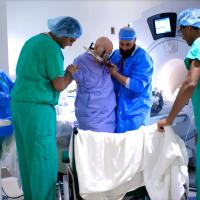This surgeon, Dr. Sunil Singhal, is making tumors glow to help doctors ensure they have removed all of the cancer cells at the surgery site. Completely removing cancer tumors can be difficult, and if a small amount remains, the cancer can recur. Sunil, the director of the Thoracic Surgery Research Laboratory at the University of Pennsylvania, came up with the idea of using glowing tumors to advance cancer surgery after an instance where it recurred in a young patient his team was confident they had cured. By using fluorescent dyes and delivery mechanisms for small drugs, they are able to imbue the cancer cells with fluorescent dye and then use ultraviolet light to make them glow. After 10 years in development, it is now in use – and is a notable improvement to cancer surgery, as it turns out around 10% of the surgeries would otherwise leave cancer cells behind.
Making tumors glow to improve cancer surgery
Up Next
